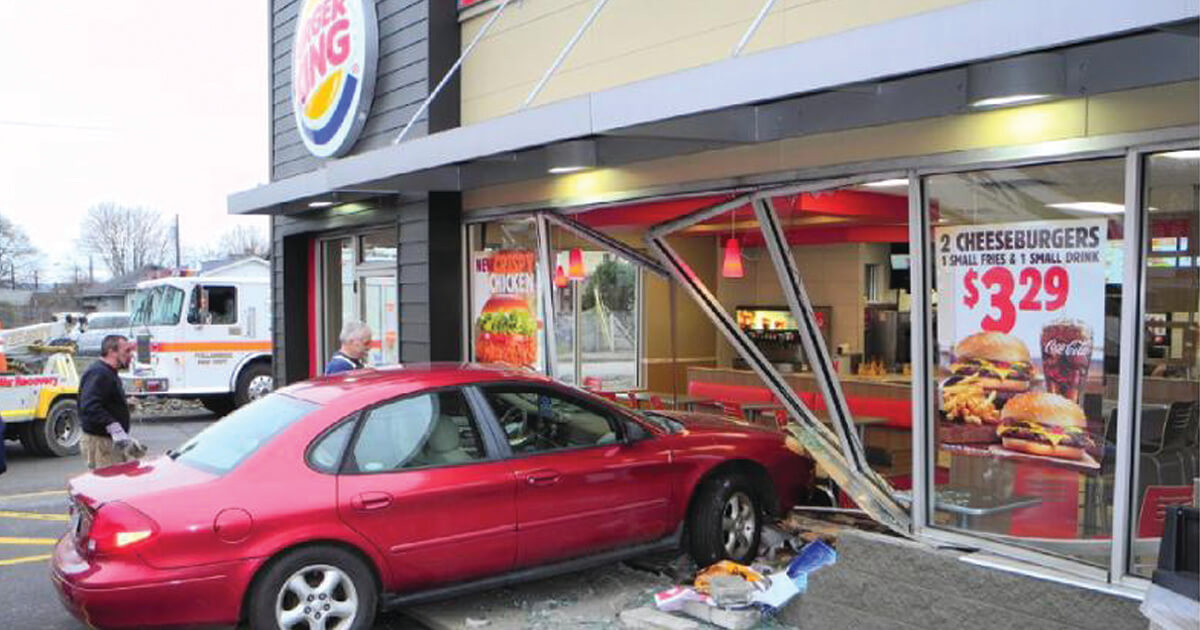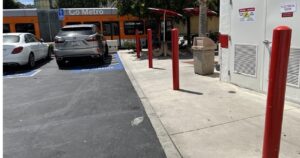Around the country, vehicles crash into buildings an average of 100 times a day, and often it’s into a restaurant. Experts say there are steps operators can take to prevent death, injury, damage and the liability that can result.
It happens just after they take their first bite of a sandwich.Two YouTube influencers sitting in a Houston restaurant enjoying a Happy Hour spread are suddenly hit by a car that comes crashing through the window. Glass comes raining down as the couple struggles to move away.
The influencers, Patrick Blackwood and Nina Santiago, suffered injuries and were hospitalized, but they are happy to be alive. The video, of course, went viral.
It seems like a freak accident. But, sadly, vehicle-into-building crashes happen all the time, by one estimate an average of about 100 times a day, somewhere around the country. And about 20% of the time, it’s a restaurant that gets hit, if only because there are just so many of them near streets and parking lots.
In July, a 2-year-old was killed and 13 others were injured in a Portillo’s in Oswego, Illinois, after a car crashed through the restaurant’s front doors facing the parking lot.
On Aug. 15 and 16, 2025 alone, three pizzerias were hit in separate states. A car veered off the street and slams into a pizzeria in New Jersey. In Louisiana, SUV plowed into another pizzeria in Covington, injuring several people, including an infant. In Greece, New York, a sedan crashed into yet another pizzeria, seriously injuring a 79-year-old inside.
And it happened again at another pizzeria in Cleveland, Ohio, less than a week later. (The driver was reportedly an off-duty police officer.)
The Storefront Safety Council, an organization that has tracked vehicle-to-building incidents for a decade, said almost 6,000 restaurants have been hit by cars, as of May 2025.
Representing about 20% of such accidents overall, restaurants are the third most common type of business to be hit by a vehicle, after retail stores (23%) and other locations not specified (28%).
Rob Reiter, co-founder of the Storefront Safety Council, said every incident should be a wakeup call for restaurant operators to take steps to prevent these sort of crashes from happening.
“The industry is on notice. It’s not like this is sneaking up on anybody,” he said. “These accidents happen where our families work, play, shop and eat lunch. And you only get one family.”
There are a number of design steps restaurant operators should consider to reduce the risk of a car ending up in their restaurant dining room. But key among them is the installation of some kind of sturdy bollard or traffic barriers that allow pedestrians but would stop a vehicle.
And the most vulnerable spot in any restaurant parking lot? The handicapped parking spaces.
Those, of course, are placed closest to the door of a restaurant to allow for easy access. But Reiter said they also tend to be where accidents resulting from “pedal error” or “driver error” can occur, especially drivers who accidentally confuse the gas and brake pedals. When such parking spots are aimed directly at the front door or window seating of a restaurant, that can result in tragedy.
But the reasons why drivers end up crashing into restaurants varies broadly. Often drugs or alcohol are a factor, or a medical incident. Many such crashes don’t cite a cause.
Whatever the reason, properly designed bollards can offer protection.
And it has to be the right kind of bollard. Some businesses have bollards that are designed simply to keep cars from parking on a sidewalk, for example, but Reiter said those may not be strong enough to stop a car, as captured by one podcaster video showing a car knocking a bollard over before hitting the window.
The liability from such accidents can be huge, notes Reiter.
In 2023, 7-Eleven agreed to pay $91 million to a man who was crushed in front of one of the chain’s stores outside Chicago. (Convenience stores are another business often hit by cars.)
And, though landlords may ultimately be responsible for parking lot safety features, it’s important for restaurants to negotiate such protections to show that they were requested, which could defer liability.
The family of the 2-year-old killed at Portillo’s in August filed a lawsuit in Cook County Illinois Circuit Court seeking $50,000 in damages from the restaurant chain. Attorneys argued that there were no barriers, fences, walls or bumpers that would have slowed a vehicle from driving onto the sidewalk and through the restaurant’s glass doors.
The lawsuit cites Storefront Safety Council data showing seven similar incidents in Illinois since 2015, including crashes at a Panera Bread, a Rosati’s Pizza and a Paris Bistro.
And it has happened at other Portillo’s restaurants in Illinois twice before, including one in Downers Grove in 2014 and another in New Lenox in 2023.
“Portillo’s knew or should have known, that the lack of a barrier to prevent a vehicle incursion was a dangerous condition,” the lawsuit said.
The driver in that case was reportedly a 50-year-old woman. The lawsuit alleges she was maneuvering into a parking spot when she suddenly accelerated her 2011 Lincoln MKZ, jumping the curb and flying into the family of 2-year-old Finnegan McKee sitting inside.
Portillo’s officials declined to comment, citing pending litigation.
Following the pandemic-era trend of restaurants serving guests outside, some states have passed legislation designed to encourage business owners to put in safety barriers. In California, for example, business owners that install vehicle barriers can get a discount on insurance.
Michael Fleming, the former CEO of Farrell’s Ice Cream, has long lobbied for stronger state laws to prevent vehicle-to-building accidents.
That’s because his business was hit. And someone was killed.
In 2014, a Farrell’s ice cream parlour in Buena Park, California, was hit when an elderly driver accidentally stepped on the gas instead of the brake while trying to park. The car hit a 71-year-old grandmother, who was killed. A teenager’s skull was fractured. Others suffered broken bones and scratches.
Fleming, who is now retired, said, “It’s still the worst day of my life.”
At the time, he didn’t know how common such accidents are, or the need for bollards. After the incident, he spent years lobbying for legislation and raising awareness in the restaurant industry about the issue.
“I would never want any restaurant owner having to go through having a fire captain come up to you and say, ‘This is now a fatality accident,’” he said.
Installing barriers is just not that expensive, he said. Not when you consider the ultimate cost of not doing it.
“To know what I know now? I would have traded 10 times that, or more, not to have heard those words about a fatality,” he said.
Source: https://www.restaurantbusinessonline.com/operations/every-day-car-slams-restaurant-somewhere-operators-need-take-action









